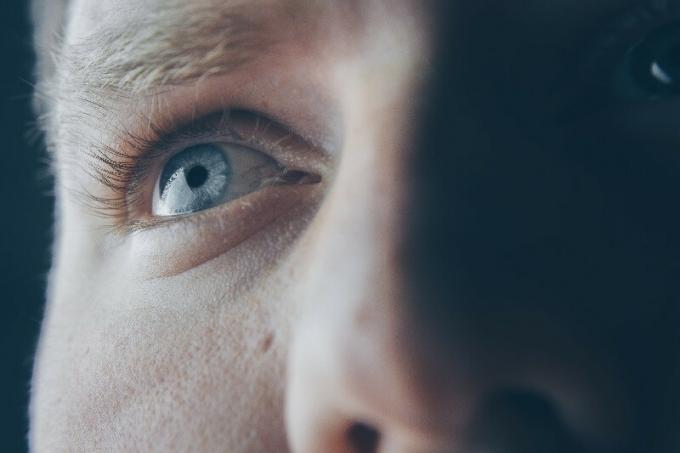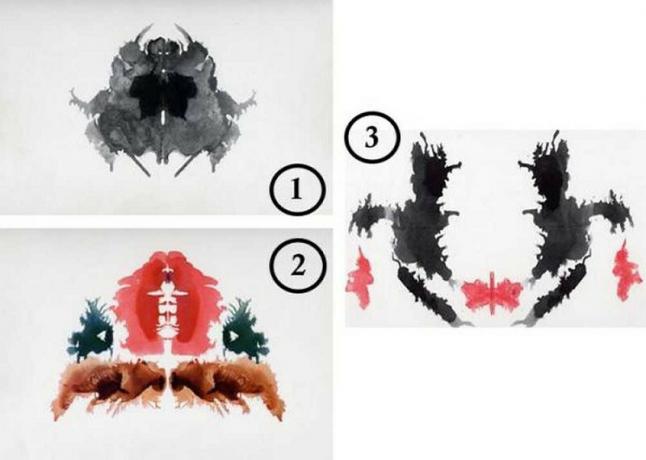Zulliger test: characteristics, operation and uses
Probably the most famous projective test in history is the Rorschach test, the famous black ink spots with abstract shapes that suggest all kinds of objects and figures.
It is likely that we have seen this test more than once but in color, something that actually corresponds to a test derived from it: the Zulliger test.
Although strongly inspired by the most well-known projective test of all, the Zulliger test has a few characteristics that differentiate it considerably from that of Rorschach, so much so that it is considered a test with greater validity and reliability. Let's see why below.
- Related article: "Types of psychological tests: their functions and characteristics"
What is the Zulliger test?
The Zulliger test, also called the Z-test, is a projective test created during World War II. This test takes strong inspiration from the classic and famous Rorschach test, however, it does not follow the same protocol and, in addition, it has multiple advantages over it. In fact, it is much easier to apply and has much faster performance parameters, as well as having more empirical evidence that gives strength to the Zulliger test as a reliable test, despite still being a test projective.
The main reason why this test is used coincides with that of any other projective instrument with origins in psychoanalysis: describe latent personality traits of the evaluated person. It is due to this premise that, despite having almost a century of application, it is still a test in the that the subject is asked to project what he observes and, therefore, the Zulliger test is not exempt from critics. Despite this, today it is still widely used in personnel selection processes.
This test is considered to be a great advantage over other projective tests as good data is available reliability and validity, something that you test like the figure in the rain, the tree test or the Murray test have. Several statistical studies have been carried out that defend that the Zulliger test has good robustness in the field of personnel selection. Instead, in the field of clinical psychology it is not widely used and, in fact, it is not considered an adequate tool for the diagnosis of any disorder.
- You may be interested in: "History of Psychology: main authors and theories"
Origin of this projective test
The fact that the Zulliger test looks so much like the Rorschach test is because Its creator, the Swiss psychiatrist Hans Zulliger, was a student of Hermann Rorschach himself, one of the most influential psychiatrists and psychoanalysts not only in Switzerland but in the entire world. Thanks to the knowledge imparted by Rorschach, Zulliger would eventually become an influential child analyst, as well as the promoter of psychoanalytic pedagogy.
Although Rorschach's pupil, Zulliger devoted himself body and soul to understanding and deepening psychoanalysis and exploring the human personality through the classic spot test of his mentor. To this would be added a decisive event in his life: the start of the Second World War and the need for rapid tests to select the Swiss army.
Despite remaining neutral during the war, Switzerland urgently needed new candidates to join the army and fill official positions. You could not accept any soldier for any position, but you had to filter and for this the best was to apply tests or psychological tests to, thus, evaluate the mental and attitudinal capacities of the future soldiers.
By then Hans Zulliger had become the chief officer of the psychological services and was in charge of administering different types of tests, among them the Rorschach plates to the candidates to evaluate their personality. Despite the fact that he considered it to be a good tool for such an objective, in the war context that was lived, the speed, which is why Zulliger decided to modify the original test so that it could be applied more quickly and in large quantities. groups.
So that, Zulliger created his own test by modifying the Rorschach test, making it simpler and with more specific administration guidelines, which allowed him to apply it collectively. This is how the Zulliger test for personnel selection was born.

- Related article: "The Rorschach inkblot test"
What does the Zulliger test evaluate?
As we mentioned, the Zulliger test is a projective test, which means that it is an instrument with which a large number of subjective responses can be obtained. What tests of these characteristics have in common is that they all start from stimuli that they awaken the imagination of the person being evaluated, as well as their sensitivity, desires, personality traits, creativity...
However, what differentiates the Zulliger test from other tests of the same style is that it has greater validity and ease when it comes to be applied, the latter being the main reason why Zulliger developed this test and, thus, achieve a more agile and efficient selection of personnel fast.
In its original conception, this test was made to be able to quickly differentiate people without psychological problems from those that could have them in addition to identifying in them adequate competencies for certain positions in the army.
Supporters of using the Zulliger test say that this test helps assess people's mental processes, as well as their fears, social adaptation, internal world, emotions, aptitudes and control capacityThis is why many human resources departments use it when selecting personnel.
- You may be interested in: "The main theories of personality"
How does it apply?
The Zulliger test can be applied both individually and collectively. In both cases, the candidate begins by presenting the three sheets that make up this test.
It is explained that the figures you see in them do not represent anything in particular and that they can evoke many different things from person to person. What they have to do as they are being evaluated is to explain what the figures they are seeing suggest to them..
An example of a slogan that can be given to the evaluated is the following:
"I'm going to show you a series of pictures. There are no good or bad answers in these pictures, and you will have to say what they could be. You can take the pictures, turn them, and view them in whole or in parts. Everything is at your discretion. While he is looking at the pictures and telling me what he thinks he sees in them, I will write what he tells me. "
The sheets that make up the Zulliger test are the following three.

Plate 1.
The first sheet has white, black and gray tones. The figures that are seen in it are compact, with slightly cropped edges and, in general, they should suggest a single concept, a global response to the evaluated. In principle, it represents deep thinking and is related to facing new situations.
According to those who use this test, when the evaluated person does not give a global answer, a momentary or fixed disturbance is suspected. In people with depression, according to supporters of this technique, express being uncomfortable when looking at this grayscale slide.
Among the most common responses when looking at this picture are: flightless insect (p. g., beetle), crab, leaf and the like.
Plate 2.
The second sheet is the most striking because it can be seen in various colors such as red, white, orange, blue or dark green, as well as various differentiated areas. It is the most complex figure, as well as the one that also awakens the greatest number of sensations and emotions, which is why it is used to evaluate affective aspects.
Some of the elements evaluated through this sheet include the ability to order, self-control, criticism and confrontation with pressure situations, all of them expressed in the form of much detail since the multi-colored sheet invites the evaluated person to do their best by giving information.
Some evaluated manifest what the supporters of the Zulliger test call “chromatic shock”. In this specific plate, this phenomenon would consist of the subject directing his responses towards the black, green and / or brown / brown spots preferably, avoiding the interpretation of the part red.
It may also be the case that, once they have recovered from the shock, the subject responds to what the color red suggests, but does so at the end. This would be related to fear of affections and fear of being rejected by others.
Among the most popular answers we have four-legged animals such as bulls, cows, buffalo... There are also those who answer this picture by indicating that what they see is an insect like an ant.
Plate 3.
Finally we have the third sheet, which play with gray, black and red tones. The drawing that is represented in this part of the test always suggests a certain dynamism and movement, and is used to evaluate the area of social relationships. It gives rise to global interpretations, of great and small details.
Normally this sheet tends to evoke responses related to movement, and among the most common figures that the evaluated usually see we have: people, butterflies, little men, elves, children, Native Americans with feather headdresses ...
- You may be interested in: "17 curiosities about human perception"
How is it evaluated?
To be able to evaluate the Zulliger test it is necessary to master this test. Being a projective test, it requires some experience and knowing what the multiple answers that can be answered by those evaluated, which is why it is not valid for anyone to apply it. The answers must be evaluated in qualitative terms, starting from the fact that there are no correct or incorrect answers..
The responses given by the evaluated in each slide are analyzed, both in its content and in the way in which it has been expressed. The more details, sensations, figures or experiences the subject has said having lived while the test was passed, the higher his score will be. Originality, psychological coherence, self-perception, the style of thinking and creativity, data that also help us to see the inner world and the personality of the candidate.
Re-question or Survey Phase
This phase is optional. It consists of reviewing the answers given by the interviewee, advancing sheet by sheet to ensure that the next phase, that of coding the responses, is carried out with the maximum information and accuracy possible. With this phase of re-questioning new information can be obtained or the information given by the individual can be specified and, thus, clearing any doubts that may have arisen during the process.
Coding
As a projective test that it is, There are different ways of coding this test, one of the most widely accepted and used being the Exner Comprehensive System..
This system allows the complete evaluation of the personality of the evaluated individual, respecting the psychometric criteria of validity and reliability. Each of the objects that the interviewee has perceived during the test is coded and measured according to pre-established guidelines, obtaining different scores and meanings.
The coding is done according to the following parameters.
1. Location
By location we mean in which area of the sheet the evaluated person perceived the object. It can be global (using the whole figure), a usual detail or an unusual detail (using some part of the figure) or blank space.
As a general rule, it is understood as the way in which we perceive information, going from the most general to the most particular and vice versa, or if we only stay in the singular or general.
2. Evolutionary quality
Evolutionary quality alerts us to the quality of the thought process behind the response that the evaluated gives us. These can be the response of:
- Synthesis: where different objects on the spot are linked and at least one of them has a specific shape.
- Vague synthesis: different objects on the spot are linked, but none have a specific shape.
- Ordinary: a delimited area of the stain is selected and articulated, emphasizing the shape and defining features of the object.
- Vague: the stain appears giving a diffuse, ambiguous or indeterminate impression.
3. Determinants
The determinants are the aspects that led the person to perceive the object seen. Among them we can mention: shape, human or animal movement (active or passive), inanimate movement, chromatic or achromatic color, shading, shape-dimension, pairs, reflections ...
Generally, the determinants denote richness and variety of imaginative and adaptive resources.
4. Contents
The contents refer to the nature to which the perceived object belongs. It can be human figures, animals, or human experiences. It can also be related to different fields of human knowledge such as art, botany, anthropology, or forces / elements of nature such as fire, water, wind, earth, clouds…
This is the most projective parameter of the entire test, showing the internal contents of the evaluated personality. Depending on what content you have shared with us, a hypothesis can be generated about possible interpersonal problems, personality traits, violent behaviors and impulses, among others.
Final aspects and conclusion
The Zulliger test has a great advantage over other projective tests, including the Rorschach test. The first is that It only takes 30 minutes to be applied, with a coding time not exceeding 2 hours (3 sheets), a noticeably shorter time compared to that of Rorschach, which takes 2 hours to be applied and 8 to be encoded (10 sheets). Added to this, it has a lot of validity and reliability, something that projective tests tend to limp with.
Thanks to the fact that it is quick to apply and that it can be used both individually and in groups, the Zulliger test is highly valued among professionals who have to assess the competencies of several subjects in a short space of time, as is the case from recruiters.
It is also highly valued in the judicial and military spheres, although it is not as relevant as more standardized personality and aptitude tests.



